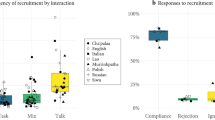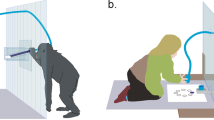Abstract
A century of research on chimpanzees, both in their natural habitat and in captivity, has brought these apes socially, emotionally and mentally much closer to us. Parallels and homologues between chimpanzee and human behaviour range from tool-technology and cultural learning to power politics and intercommunity warfare. Few behavioural domains have remained untouched by this increased knowledge, which has dramatically challenged the way we view ourselves. The sequencing of the chimpanzee genome will no doubt bring more surprises and insights. Humans do occupy a special place among the primates, but this place increasingly has to be defined against a backdrop of substantial similarity.
This is a preview of subscription content, access via your institution
Access options
Subscribe to this journal
Receive 51 print issues and online access
$199.00 per year
only $3.90 per issue
Buy this article
- Purchase on Springer Link
- Instant access to full article PDF
Prices may be subject to local taxes which are calculated during checkout



Similar content being viewed by others
References
Oakley, K. Man the Tool-Maker (Univ. of Chicago Press, Chicago, 1957)
Köhler, W. Mentality of Apes (Routledge & Kegan, London, 1925)
Yerkes, R. M. Chimpanzees: A Laboratory Colony (Yale Univ. Press, New Haven, 1943)
Ladygina-Kohts, N. N. in Infant Chimpanzee and Human Child: A Classic 1935 Comparative Study of Ape Emotions and Intelligence (ed. de Waal, F. B. M.) (Oxford Univ. Press, Oxford, 2001)
Nissen, H. A field study of the chimpanzee. Comp. Psychol. Monogr. 8, 1–122 (1931)
Goodall, J. in Primate Behavior: Field Studies of Monkeys and Apes (ed. DeVore, I.) 425–473 (Holt, Rinehart & Winston, New York, 1965)
Nishida, T. The social group of wild chimpanzees in the Mahali Mountains. Primates 9, 167–224 (1968)
Goodall, J. et al. in The Great Apes (eds Hamburg, D. A. & McCown, E. R.) 13–53 (Benjamin/Cummings, Menlo Park, California, 1979)
Gallup, G. G. Jr . Chimpanzees: Self-recognition. Science 167, 86–87 (1970)
Menzel, E. W. in Behavior of Non-human Primates Vol. 5 (eds Schrier, A. M. & Stollnitz, F.) 83–153 (Academic, New York, 1974)
Hauser, M. Our chimpanzee mind. Nature doi:10.10.38/nature03917 (this issue)
de Waal, F. B. M. Chimpanzee Politics: Power and Sex Among Apes (Jonathan Cape, London, 1982)
Mitani, J. C., Watts, D. P. & Muller, M. Recent developments in the study of wild chimpanzee behaviour. Evol. Anthropol. 11, 9–25 (2002)
Whiten, A. The second inheritance system of chimpanzees and humans. Nature doi:10.1038/nature04023 (this issue)
Goodall, J. The Chimpanzees of Gombe (Harvard Univ. Press, Cambridge, 1986)
Wilson, M. L. & Wrangham, R. W. Intergroup relations in chimpanzees. Annu. Rev. Anthropol. 32, 363–392 (2003)
de Waal, F. B. M. The brutal elimination of a rival among captive male chimpanzees. Ethol. Sociobiol. 7, 237–251 (1986)
Watts, D. P. Intracommunity coalitionary killing of an adult male chimpanzee at Ngogo, Kibale National Park, Uganda. Int. J. Primatol. 25, 507–521 (2004)
de Waal, F. B. M. & van Roosmalen, A. Reconciliation and consolation among chimpanzees. Behav. Ecol. Sociobiol. 5, 55–66 (1979)
Wittig, R. M. & Boesch, C. “Decision-making” in conflicts of wild chimpanzees (Pan troglodytes): An extension of the Relational Model. Behav. Ecol. Sociobiol. 54, 491–504 (2003)
Aureli, F. & de Waal, F. B. M. Natural Conflict Resolution (Univ. California Press, Berkeley, 2000)
Hrdy, S. B. Infanticide among animals: A review, classification, and examination of the implications for the reproductive strategies of females. Ethol. Sociobiol. 1, 13–40 (1979)
Hiraiwa-Hasegawa, M. & Hasegawa, T. in Infanticide and Parental Care (eds Parmigiani, S. & vom Saal, F. S.) 137–154 (Harwood Academy, London, 1994)
Arcadi, A. & Wrangham, R. Infanticide in chimpanzees: Review of cases and a new within-group observation from the Kanyawara study group in Kibale National Park. Primates 40, 337–351 (1999)
Pusey, A. E., Williams, J. & Goodall, J. The influence of dominance rank on the reproductive success of female chimpanzees. Science 277, 828–831 (1997)
de Waal, F. B. M. Tension regulation and nonreproductive functions of sex among captive bonobos. Nat. Geogr. Res. 3, 318–335 (1987)
Harcourt, A. H., Harvey, P. H., Larson, S. G. & Short, R. V. Testis weight, body weight and breeding system in primates. Nature 293, 55–57 (1981)
Reno, P. L., Meindl, R. S., McCollum, M. A. & Lovejoy, C. O. Sexual dimporphism in Australopithecus afarensis was similar to that of modern humans. Proc. Natl Acad. Sci. USA 100, 9404–9409 (2003)
Constable, J., Ashley, M., Goodall, J. & Pusey, A. Noninvasive paternity assignment in Gombe chimpanzees. Mol. Ecol. 10, 1279–1300 (2001)
Vigilant, L., Hofreiter, M., Siedel, H. & Boesch, C. Paternity and relatedness in wild chimpanzee communities. Proc. Natl Acad. Sci. USA 98, 12890–12895 (2001)
Nishida, T. Alpha status and agonistic alliance in wild chimpanzees. Primates 24, 318–336 (1983)
de Waal, F. B. M. The chimpanzee's service economy: Food for grooming. Evol. Hum. Behav. 18, 375–386 (1997)
de Waal, F. B. M. & Luttrell, L. M. Mechanisms of social reciprocity in three primate species: Symmetrical relationship characteristics or cognition? Ethol. Sociobiol. 9, 101–118 (1988)
Stanford, C. B. Chimpanzee and Red Colubus (Harvard Univ. Press, Cambridge, 1998)
Boesch, C. in Animal Social Complexity (eds de Waal, F. B. M. & Tyack, P. L.) 93–110 (Harvard Univ. Press, Cambridge, 2003)
Nishida, T., Hasegawa, T., Hayaki, H., Takahata, Y., Uehara, S., et al. in Topics in Primatology Vol. 1: Human Origins (ed. Nishida, T.) 159–174 (Univ. Tokyo Press, Tokyo, 1992)
Author information
Authors and Affiliations
Corresponding author
Ethics declarations
Competing interests
Reprints and permissions information is available at npg.nature.com/reprintsandpermissions. The author declares no competing financial interests.
Rights and permissions
About this article
Cite this article
de Waal, F. A century of getting to know the chimpanzee. Nature 437, 56–59 (2005). https://doi.org/10.1038/nature03999
Issue Date:
DOI: https://doi.org/10.1038/nature03999
This article is cited by
-
On the need to redress an inadequacy in animal welfare science: toward an internally coherent framework
Biology & Philosophy (2012)
-
Major chimpanzee-specific structural changes in sperm development-associated genes
Functional & Integrative Genomics (2011)
-
The ethics of using transgenic non-human primates to study what makes us human
Nature Reviews Genetics (2010)
-
Postnatal stem/progenitor cells derived from the dental pulp of adult chimpanzee
BMC Cell Biology (2008)
-
Human uniqueness: genome interactions with environment, behaviour and culture
Nature Reviews Genetics (2008)
Comments
By submitting a comment you agree to abide by our Terms and Community Guidelines. If you find something abusive or that does not comply with our terms or guidelines please flag it as inappropriate.



